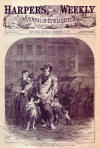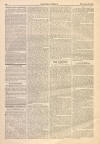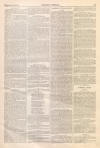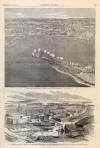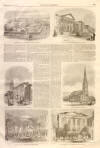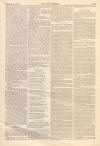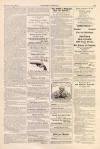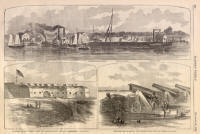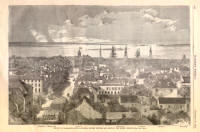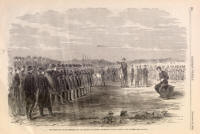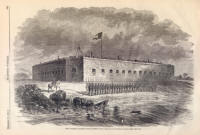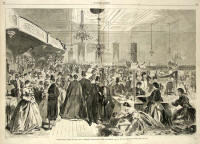The Charleston Fire
|
|
This Site:
|
DECEMBER 28, 1861.] HARPER'S WEEKLY. 823 BIRDSEYE-VIEW OF CHARLESTON, SOUTH CAROLINA. GROUP OF BANKS, CHARLESTON, SOUTH CAROLINA. THE BURNING OF CHARLESTON.WE devote this and the preceding page to illustrations of the CITY OF CHARLESTON, South Carolina, which, we hear by telegraph, was mainly destroyed by fire on 11th and 12th. The dispatch from Fortress Monroe states : The fire commenced in Charleston last night (December 11), at nine o'clock, in Ruzel & Co.'s sash factory, at the foot of Hazel Street, and communicated to the opposite side of Hazel, to Cameron & Co.'s machine shops. Under the impulse thus given and a stiff breeze, with a small supply of water, the conflagration assumed a formidable character, nearly equaling the most extensive conflagration on the American continent. The Theatre, Floyd's coach factory, opposite the Express office, the old Executive Building, and all the houses between that point and Queen Street, are burned. The whole of one side of Broad Street is destroyed, from Colonel Gadsden's residence to Mazyck Street. A considerable portion of the city, from East Bay to King Street, is destroyed. Among the prominent buildings burned are the Institute and St. Andrew's halls, Theatre, Catholic Cathedral, and the Circular Church. At last accounts from Charleston the fire had crossed Broad Street, and was sweeping furiously on. Nearly all that part of the city from Broad Street on the south, East Bay Street on the east, and King on the west, is said to be destroyed. An extra train had left Augusta with supplies for the sufferers—thousands of whom roamed the streets—and assistance to fight the fire. There are rumors of a negro insurrection and negro incendiarism. One account states that a plot was disclosed by the body-servant of a military officer, who said that the negroes of the city were to be joined by large bands of negroes from the country, who were to come in armed at night. He said that the sash factory had been fired by a free negro, whom he designated, and who has been arrested. A small quantity of arms had been found under the floor of a negro cabin. They were all new and in good order. In other negro cabins knives and hatchets were found secreted. The greatest consternation prevailed. Families were closing and barring their windows. The fire companies being composed of men who are engaged on military duty elsewhere, the fire-engines were worked by negroes, who broke and rendered useless the two best ones. The offices of the Courier and Mercury are said to be destroyed. Another account states that negro insurrections broke out in the interior of South Carolina two days before the fire, and are still raging unchecked; but this last report is not well authenticated. The following history of the city of Charleston is from the Herald: The city of Charleston is one of the oldest in the United States , having been founded in 1672. Its population was recruited some years afterward by Huguenot refugees who emigrated from France and settled in pretty considerable numbers in South Carolina. From this stock many of the first families of that region now claim to be descended. It was not till 1783 that it was incorporated as a city. Fifty-two years previously, in 1731, it contained six hundred houses and five churches, and a thriving business was done in its port. During the Revolutionary War the possession of the harbor of Charleston was the object of more than one British expedition. A garrison of four hundred on Sullivan's Island, under command of Colonel Moultrie, achieved great distinction by the repulse, on 28th June, 1776, of a British squadron of nine ships-of-war. On the 12th of May, 1780, the city was surrendered to Sir Henry Clinton by General Lincoln, the corporation and principal inhabitants refusing to co-operate in its defense, and offering to acknowledge the sovereignty of Great Britain. The British held it till May, 1782. It contains some thirty churches, a theatre, several excellent hotels, cotton presses and factories, engine and machine factories, ship-yards, and a large dry dock. Its banks and other moneyed corporations enjoyed a high reputation until the secession mania brought destruction upon the city and all its institutions. It has suffered greater disasters by fire than almost any other city in the United States. In 1778 there were two hundred and fifty-two houses consumed ; in 1796 nearly a third of the city was destroyed, involving loss of property to the amount of $2,500,000. Again, in the great fire of 1838, the loss was estimated at $5,000,000. Mr. Simms, in Harper's Magazine for June, 1857, describes some of the buildings, now burned, which appear in our illustrations. Of the "Group of Banks" he says: "That huge, heavy, and somewhat unsightly fabric in the fore-ground is the Planters' and Mechanics' Bank, a structure of the Charleston medieval period. Without, it is a most imposing deformity—a miserable abuse of a mixed model. Next is the Farmers' and Exchange Bank, a fanciful little fabric, a little too ornate for such a worship, and showing beside the Planters' and Mechanics' as a toy-box under the eaves of the Tower of Babel. The building just above is a shop and warehouse, and gives a very fair idea of the style and size of building usually allotted in Charleston to the retail traders. The tall structure further on is the Union Bank, of an old style, but not the oldest in Charleston architecture. Beyond, all the houses are employed in trade— shops, warehouses," etc. Mr. Simms says that the Roman Catholic Cathedral of St. John and St. Finbar "occupies a fine situation at the west end of Broad Street. It is of recent erection, of brown freestone, from a design by Keely, of Brooklyn. Its style is graceful and imposing." Of the Circular Church Mr. Simms says : "This church belongs to the medieval period of the Palmetto City. But recent repairs and alterations have somewhat modernized and improved it; and it is now such an edifice as will not offend the eye of a critical inspector." The South Carolina Institute, which appears in the same view, is described as a structure of the Italian style, with a facade of eighty feet ; the entrance being through a lofty arch-way, with staircases leading to the great hall above, capable of seating three thousand persons. This paper by Mr. Simms contains views and descriptions of all the principal buildings in Charleston: and if, as we have reason to suppose, these buildings have been destroyed, this Magazine article may be the only memorial existing of Charleston as it existed before the Great Rebellion. Speaking of the fire, the Herald says: "Does it not look like a retribution of Providence, and an omen and a type of the future destruction of the rebellion ?" CIRCULAR CHURCH AND SOUTH CAROLINA INSTITUTE. ROMAN CATHOLIC CATHEDRAL. HIBERNIAN HALL, CHARLESTON, SOUTH CAROLINA.ST. ANDREW'S HALL, CHARLESTON, SOUTH CAROLINA.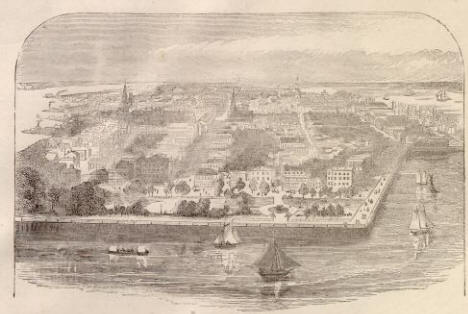 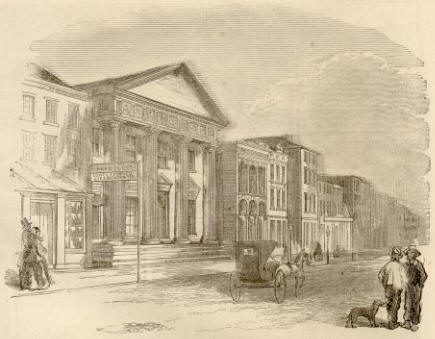 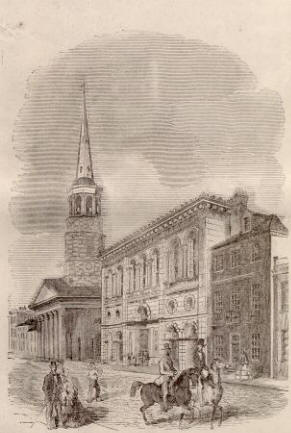 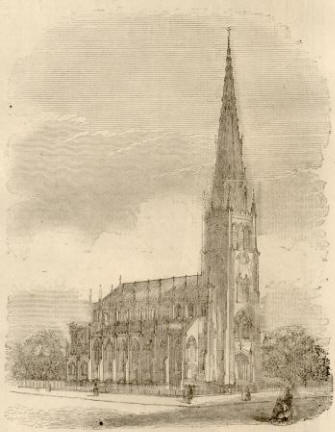 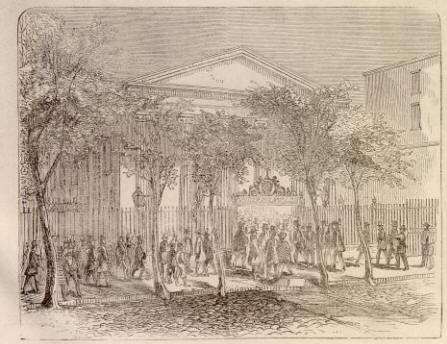 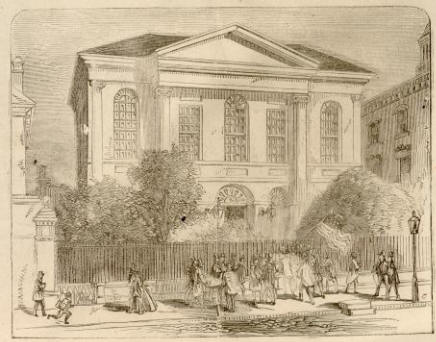 |
||||||||||||||||||||||||||||||||
|
|
||
|
|
Site Copyright 2003-2018 Son of the South. For Questions or comments about this collection, contact: paul@sonofthesouth.net |
|
|
Are you Scared and Confused? Read My Snake Story, a story of hope and encouragement, to help you face your fears. |
||
